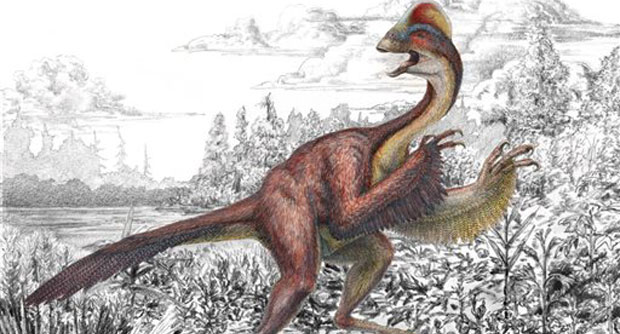
This illustration provided by the Carnegie Museum of Natural History on March 18, 2014 shows the dinosaur Anzu wyliei. The birdlike animal, about 7 feet tall, weighed an estimated 500 pounds when it roamed western North America around 66-68 million years ago. Nicknamed the “chicken from hell,” the creature was formally introduced with an official name to the scientific community Wednesday, March 19, 2014 as scientists published a description and analysis of its anatomy. AP
NEW YORK — It’s called the chicken from hell: a birdlike dinosaur some 7 feet (2.1 meters) tall that weighed around 500 pounds (226 kilograms) when it roamed western North America on its long, slender hind legs.
The beast got its nickname long ago at the Carnegie Museum of Natural History in Pittsburgh, where a replica of its skeleton has been on display for a decade.
But the species has had no scientific name. Until now.
The creature was formally introduced to the scientific community Wednesday as scientists published a description and analysis of its anatomy, and finally bestowed a name: Anzu wyliei. The moniker comes from a mythological feathered demon plus the name of a Carnegie museum trustee’s grandson.
Anzu had a toothless beak and a crest on its skull like a rooster’s comb, combined with long arms and sharp claws up to about 4 inches (10 centimeters) long. It apparently also had feathers over much of its body.
The analysis, in the journal PLoS One, concludes that Anzu belongs to a group of dinosaurs that scientists knew little about, because they had recovered only fragmentary remains from its members. In contrast, the three specimens of Anzu from North and South Dakota that were included in the analysis collectively supply a nearly complete skeleton, said Matthew Lamanna of the Carnegie museum.
Anzu “reveals the anatomy of these creatures almost from head to toe,” said Lamanna, lead author of the new paper.
The dinosaur lived some 66 million to 68 million years ago in a hot and humid landscape, rather like the Louisiana bayou, he said. It ate plants and maybe small animals when it wasn’t fleeing from a hungry and much bigger T. rex, he said.
When it came to naming the creature, why not go with a spiffed-up version of “chicken from hell?”
That was actually the first choice, Lamanna said. But it turns out the phrase isn’t nearly as catchy in Latin or Greek.
“All the names we came up with were just ridiculously unpronounceable,” he said.
So “I thought that if I couldn’t come up with a name that literally meant ‘chicken from hell,’ I could at least name it ‘feathered demon.’ ”
RELATED STORIES
Fossilized embryos shed light on dinosaur development
Pawikans survived the dinosaur age
Bird brains have a dinosaur source—study

